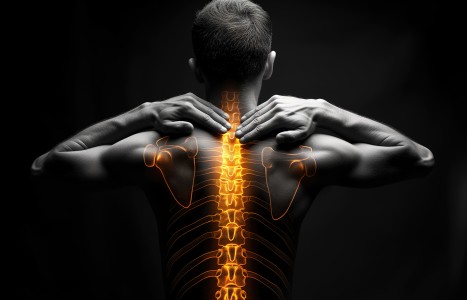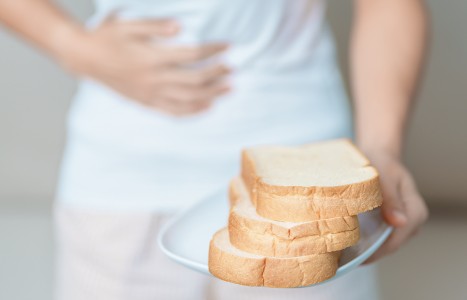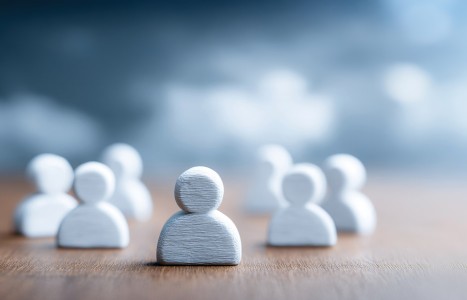After a thorough examination to rule out the cervical and thoracic spine, what you have left is sharp, localized qi stagnation of the soft tissues causing the “rhomboid pain.” If it’s not the C or T spine causing the problem, then what could be causing this tissue issue? It can be a bunch of different reasons such as dehydration, electrolyte imbalance, poor posture, muscle imbalances, trauma, deconditioning, overuse, etc.
Plantar Fascitis and Plantar Aponeurositis: An Integrated Approach in the Training Room
Western Perspective
Plantar fascitis is inflammation of the plantar fascia located on the sole of the foot. Pain is generated at the attachment of the fascia near the medial tubercle on the calcaneus. The injury can be caused by overuse as a result of excessive loading, wearing shoes with inadequate support and/or cushioning. Pain is located on the bottom of the foot, and is worse in the morning and with walking.
To treat plantar fascitis and plantar aponeurositis from a Western perspective, one must understand the injury mechanism: an overcontracted muscle progressing through tendonitis stages of severity. Once this is accomplished, one prioritizes whether to treat the inflammation or the cause. Ice, ultrasound at 20 percent intensity (for its non-thermal effect), MENS (microcurrent electrical stimulation) units and anti-inflammatory drugs can be used to reduce swelling. One aspect that must be taken into account is whether the practitioner wants to treat a symptom or take care of what is causing the muscle to contract. Although it may be more important to address the cause in some instances, treating the inflammation might be the only option if a time frame is involved. Once the cause is identified, heat can be applied in the form of ultrasound at 100 percent intensity, stretching, rest and massage.
TCM Perspective
According to traditional Chinese medicine, the bottom of the foot can be related to many patterns of differentiation such as wind, cold, heat and damp (six external pathogens), qi/blood stagnation in the channels, qi/blood deficiency, and Kidney jing/essence deficiency.
The deficiency conditions generally relate to weak constitution, overstrain, poor eating habits, and prolonged chronic diseases. Excessive bleeding may be specific to blood deficiency, and specific Kidney deficiency may be caused by excessive sexual activity and multiple pregnancies. When the qi and blood become deficient, they cannot properly perform their functions of movement and nourishment. Thus, the affected target areas are the channels, bones, muscles and tendons. When the Liver and Kidney become deficient, they can perform neither their primary nor supporting functions, and rely upon the jing/essence for support. This causes jing/essence deficiency, which in turn cannot nourish the muscles, tendons and bones.
| Excess Conditions | Deficient Conditions | ||
| TCM Diagnosis | Type | TCM Diagnosis | Type |
| Stagnation Qi/Blood | Pain is fixed, stabbing, and/or aggravated at night, alleviated by movement | Qi Deficiency | Aggravated by being tired and fatigued, over exertion, better with rest |
| Wind Cold Damp | Acute, aggravation of pain by wind, cold, humid weather, heavy cold extremities | Blood Deficiency | Numbness, aggravated around menses onset |
| Damp Heat | Swelling, hot/heavy sensation, redness, aggravated by warmth, better with cold | Kidney Jing Deficiency | Worse with being tired and better with rest. |
Excess conditions generally tend to be related either through the Spleen's function of transportation of obstructions (transformation transportation) and/or qi and blood. The Spleen, located in the middle jiao, tends to get congested through poor eating habits and consumption of excessive cold or spicy foods, which allows dampness to accumulate. Dampness creates an obstruction, the severity of which is dependent upon the length of the obstruction. Over time, this damp accumulation affects the flow of the qi and blood, and creates deficiency. Another scenario is the qi and blood becoming stagnation due to acute injuries (trauma, operations, infections, etc.). This creates a sudden blockage, restricting the normal flow of qi/blood, affecting the muscles and tendons.
| Excess Conditions | Deficient Conditions | ||
| TCM Diagnosis | Points | TCM Diagnosis | Points |
| Stagnation Qi/Blood Jin Gu Die Da Wan (muscle bone injury pills) Xiao Huo Luo Dan (minor invigorate the collaterals special pill) | LI 4/LV 3 - Source points, eliminate blood stagnation, increase circulation of qi, decrease/relieve pain SI 4 - Source point GB 34 - Sea point, strengthens tendons, relieves pain ST 3 - Stream point SP 6 - crossing point 3 Yin channels of the foot, eliminates stagnation, increases blood circulation UB 60 - eliminates blood stagnation in greater yang channels, increases blood circulation | Qi Deficiency Bu Zhong Yi Qi Wan (tonify middle benefit the qi pill) | K 3, LV 3, UB 64 - Source points, strengthen bones/tendons, tonify Liver/Kidney ST 36 - Sea point, promotes production of qi, tonifies Spleen/Stomach SP 6 - crossing point 3 yin channels of the foot, eliminates stagnation, increases blood circulation UB 60 - eliminates blood stagnation in greater yang channels, increases blood circulation SI 4 - Source point |
| Wind Cold Damp Tian Ma Qu Feng Bu Pian (gastrodia dispel wind) Feng Shi Pian (wind damp) | LI 4 - Source point, dispel external pathogens UB 64, SI 4 - Source points, eliminate damp, promote urination, dispel wind SI 3 - Stream point UB 63 - Accumulation point SJ 5 - Connecting point LV 3 - Source/stream point SP 6 - crossing point 3 yin channels of the foot, eliminates stagnation, increases blood circulation Moxa warms channels, dispels cold (LI 4, SI 3, SI 4, UB 64, UB 63, SJ 5) | Blood Deficiency Ba Zhen Wan (eight precious pill) | GB 39 - Gathering point for marrow, strengthens bone/tendons GB 34 - Gathering point for tendons R 16 - Tonifies qi, tonifies jing SI 4 - Source point SI 3 - Stream point K 3, LV 3 - Source points, strengthen bones/tendons, tonify Liver/Kidney ST 36 - Sea point, promotes production of qi, tonifies Spleen/Stomach SP 6 - crossing point 3 Yin channels of the foot, eliminates stagnation, increases blood circulation |
| Damp Heat Feng Shi Xiao Tong Wan (wind damp dispel pain pill) San Miao San (three marvel pill) | UB 64, SI 4 - Source points, eliminate damp, promote urination GB 34, SP 9 - Sea points, eliminate damp heat in lower jiao SI 3 - Stream point UB 63 - Accumulation point K 2 - Spring point, eliminates damp heat in lower jiao, clears heat, promotes urination SJ 6 - eliminates damp heat SP 6 - crossing point 3 yin channels of the foot, eliminates stagnation, increases blood circulation | Kidney Jing Deficiency Du Huo Ji Sheng Wan (angelica pubescens-loranthus pill) | LV 8, K 10 - Sea points together with LV 3, K 3 - Source points - both tonify Liver/Kidney, strengthen bones/tendons and benefit Kidney jing K 5 - Accumulation point and K 4 - Connecting point both tonify qi/blood circulation in Kidney channel and harmonize collaterals UB 64 - Source point, increases blood/qi circulation in the Urinary Bladder channel SP 6 - crossing point 3 yin channels of the foot, eliminates stagnation, increases blood circulation |
The result of the TCM patterns of differentiation reflects the physiological manifestations within the Western paradigm.
There are more formulas and other acupuncture point combinations that are also effective; this is just one perspective.
In summary, to understand treating sports injuries specific to plantar fascitis and/or plantar aponeurousitis is to understand jargon in both Western and Eastern arenas. Treating with TCM is extremely effective when applied in conjunction with TCM philosophy. The points and formulas are given as an example of what can possibly be used, not as the only method of use. There are a variety of points that can be combined when treating plantar conditions, along with a variety of herbal formula patents on the market. Acupuncture is like geometry. There are many different ways to develop your acupuncture prescription; the key is understanding which access route you choose and why, so you can modify your treatments accordingly. This is the beauty of Oriental medicine: getting results by thinking through the solution, and by being outside of the traditional box. Ultimately, our goal is to provide result-oriented outcomes for the patient. Educating patients and medical professionals preserves the integrity of our professional medical expertise.
References
- Xinnong C (chief editor). Chinese Acupuncture and Moxibustion. Beijing: Foreign Languages Press, 1990.
- Maciocoa G. Foundations of Chinese Medicine. New York: Churchill Livingstone, 1989.
- Kaptchuk T. The Web That Has No Weaver. Ontario: Congdon & Weed, 1983.
- Wiseman N, Ellis A. Fundamentals of Chinese Medicine. Brookline: Paradigm, 1985.
- Zhang E (editor-in-chief). Basic Theory of Traditional Chinese Medicine. Publishing House of Shanghai College of Traditional Chinese Medicine, 1990.
- Chung CS, Lai YK. Principles of Dialectical Differential Diagnosis and Treatment. Traditional Chinese Medical Publisher, 1982.
- Bensky D, O'Connor J. Acupuncture: A Comprehensive Text. Chicago: Eastland Press, 1981.
- Zhongan S, Aung S, Deadman P. The Treatment of Pain with Chinese Herbs and Acupuncture. Churchill Livingstone (China), 2002.
- Bensky D, Barolet R. Chinese Herbal Medicine: Formulas & Strategies. Seattle: Eastland Press, 1990.
- Booher T. Athletic Injury Assessment, 4th ed. McGraw-Hill, 1994.
- Hertling D, Kessler RM. Management of Common Musculoskeletal Disorders: Physical Therapy Principles and Methods, 2nd ed. Philadelphia: J.B. Lippincott, 1990.
- Snider RK. Essentials of Musculoskeletal Care. American Academy of Orthopaedic Surgeons, 1997.


